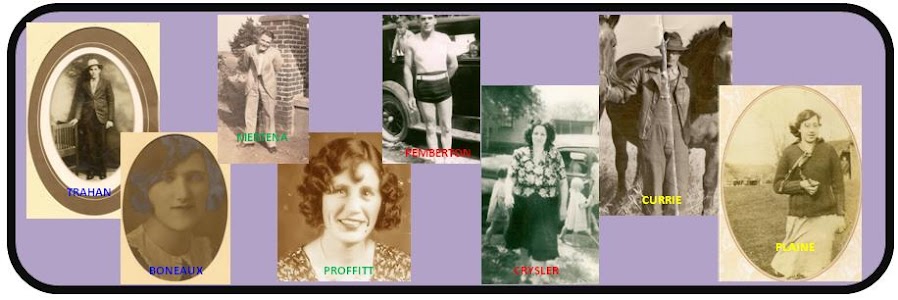According to the National Archives, the influenza epidemic, also called the Spanish Flu, of 1918 killed more people than World War I and within one year dropped the average lifespan by 12 years in the U.S. The first outbreak occurred in spring 1918 and was not too severe. It was called the "three-day fever" and few deaths were reported. When it resurfaced in the fall, the disease was more severe, causing some victims to die within a few hours of getting their first symptoms. Young adults were among the hardest hit groups. My sister said the PBS documentary said that the reason was that this flu caused immune systems to be over-reactive, and since young adults already had very active immune systems (when compared to young children or the elderly), this put them in a worse position.
I did a search in my Legacy Family Tree database of all people who had a death date after 1917 and before 1920. I came up with one definite influenza victim and another possible one.
The definite victim was Louise Elizabeth (Plonkey) Kelly McNamara. Louise was the great-aunt of my uncle, James "Jim" Chamberlain. She was the older sister of his maternal grandmother, Alma Albertine Plonkey. Louise was born 16 Mar 1885 in either Wallaceburg or Dover Township in Kent County, Ontario, to Francois Xavier "Frank" Plonkey and Philomene Demers. She was the 7th of 11 children born to Frank and Philomene. She married Phillip Kelly, son of James Kelly and Bridget Walsh, on 26 Feb 1902 in Wallaceburg, at the age of 16. It seems that she and Phillip either divorced or he died, because she was married to James McNamara and living in Cleveland, Ohio, at the time of the 1910 U.S. Census. They had two sons, John McNamara, age 7, and Bart McNamara, age 5. It is hard to make out, but it looks like James worked as a huckster, which is someone who sells small articles, usually of cheap or shoddy quality, or one engaged in making bargains or haggling. Unfortunately, eight years later, on 6 Dec 1918, at age 33, Louise succumbed to the pneumonia brought about by the influenza epidemic. Here is a copy of her death record found in the "Ohio Deaths 1908-1953" database at FamilySearch Labs.

The possible victim was my great-great-uncle, Orville Joseph Pemberton. Orville was born 17 Apr 1918 in New Baltimore, Macomb, Michigan, to Lovell Hugh Pemberton and Alvina Lesperance. He was the younger brother of my great-grandfather, John Vital "Jack" Pemberton, who was born ten years earlier in 1908. Orville died 23 Mar 1919 at the age of 11 months in Marine City, St. Clair, Michigan. According to his death record, he died of spinal meningitis. I looked at a handwritten family history passed down to me from my maternal uncle and noticed that it had "five or six crosses - flu epidemic at St. Clair" written next to Orville's death date. So I have to wonder if the spinal meningitis was brought on by the influenza. I'm assuming the five or six crosses are a memorial to the deaths from the flu epidemic. I have put a query on the St. Clair County message board at Rootsweb to find out if this memorial still exists.
So there you have it! My family tree within the larger context of the worldwide influenza epidemic of 1918.



I also have relatively young relatives that seemed to drop off the face of the earth. A few were in the 1910 and not there in 1920. This gives me an idea of where to search now.
ReplyDeleteFascinating post. I, too, am interested in the influenza epidemic and found at least one relative - Alice Floyd Ezell Bibb, a first cousin twice removed - who died on the same day as her husband in this epidemic, and this was only one of many tragedies this family experienced (did a post on them on my blog). It must have been horrifying to see people fall victim to this illness so suddenly.
ReplyDeleteA most interesting post. I have not checked to see if the Spanish Flu took any of my family tree members, but when I was photographing a The Hampton Cemetery in Hampton Township, in Pittsburgh, PA, I found numerous people that died in that time span. As I added them to findagrave I wondered what in the world killed so many folks in the same area within the same time span. You have answered my question. THANKS!
ReplyDeleteWow! I am so excited that everyone found this post fascinating and informative! I first heard about the epidemic from Miriam Robbins Midkiff's "Ancestories" blog when she wrote her WWI series. Then when my sister said she was interested, I thought it may be worth checking out how such a large epidemic affected our family tree.
ReplyDelete